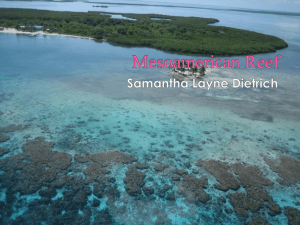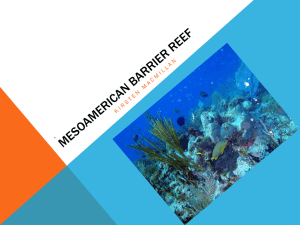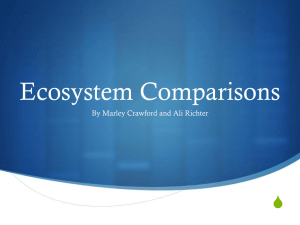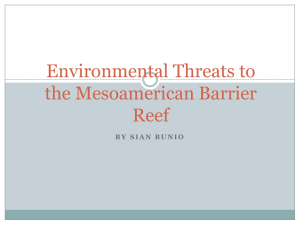Environemental impacts on Mesoamerican reef
advertisement
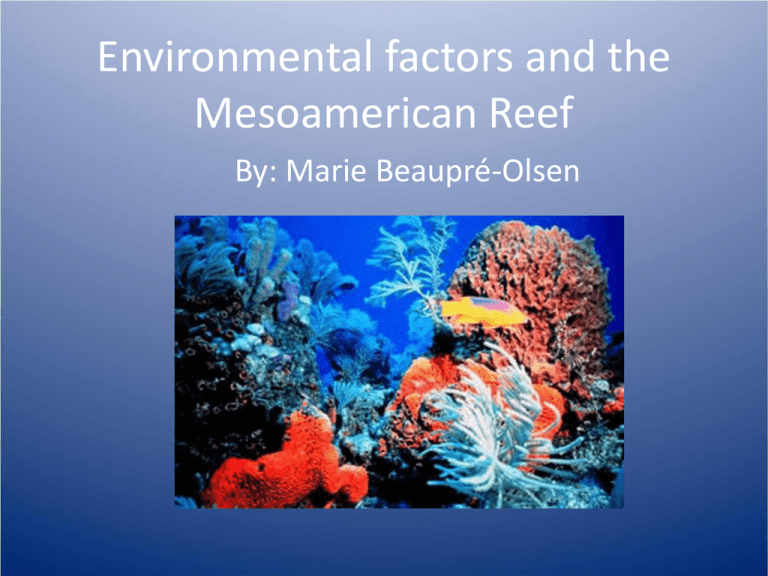
Environmental factors and the Mesoamerican Reef By: Marie Beaupré-Olsen Introduction . A section of the nearly 700-mile-long Mesoamerican Reef that reaches from Mexico to Honduras, the Belize reef suffered a severe bleaching in 1998, with a loss of 50 percent of its coral in many areas, including much of its distinctive staghorn coral.Since the bleaching, its decline has continued, due to global warming of the world's seas, agricultural pollution, development, and increasing tourism, which has given rise to more coastal development and an invasion of cruise ships. Some severe which will be explored in this powerpoint are farming and mining practices and fishing. Farming and mining Practices • Around the world there is a lot of destruction happening. This is the process which a habitat is no longer able to support its species resulting the the reductions of biodiversity. The main human influences leading to this are destruction for agriculture, urbanization, mining, logging, trawling and urban sprawl. This issue is ranked the primary cause of species extinction. Habitat degradation, fragmentation, and pollution are aspects of habitat destruction, but not necessarily driving extreme destruction of habitat. They rather result in desertification, deforestation, and coral reef degradation. Mining Practices • Human began to mine the ocean floor for diamonds, gold, silver, metal ores and gravel mines in the 1950’s. Metal compounds, gravels, sands and gas hydrates are also mined in the ocean. Mining manganese nodules containing nickel, copper and cobalt began in the 1960’s. Mining the ocean can be devastating to the natural ecosystems. This pulls up the ocean floor resulting in widespread destruction of marine animal habitats, as well as wiping out huge numbers of fish and invertebrates. When the ocean floor is mined a cloud of sediment rises up in the water, interfering with photosynthetic processes, in addition to introducing heavy metals into the food chain. Mining Mining: BP oil spill • http://www.youtube.com/watch?v=lY-PikuXTYY • Largest accidental marine oil spill in the history of petroleum history. • Estimated 4.9 millions barrels of oil spilled approximately 53,000 barrels a day. Open for 100 days. • The spill caused extensive damage to marine and wildlife habitats. • Tar balls were found in shrimp nets, tar balls found washed up on shore, and oil trails found in wakes of fishing boats. Crude lies in deep water and sands on shore. • A research team found oil on the bottom of the seafloor in February 2011 that did not seem to be degrading. Mining: Bp oil spill • The corals are being suffocated by the oil coating that experts predict is occurring in result of the oil plumes that were extended underwater in the gulf. • What is effecting the reef is not pure oil itself, but natural gas and the dispersant chemical used by BP, Corexit. This chemical effects the corals similar to how dishwashing detergent would have. It negatively impacts their ability to colonize and reproduce. Farming • Rising population densities, associated coastal development, and increased industrial activities are resulting in increased pressure on Caribbean coral reefs. A wide range of human activities directly threaten coral reefs, resulting in degrading in many areas. Even if the reefs are in the ocean there are indicators that point to land based sources that threat the reefs. • Anthropogenic influences are estimated to threaten 60 percent of the world’s reefs. Farming Runoff and erosion are natural environmental processes, however human activities increase both these processes. Evidently this increases the level of sediments and pollutants into costal ecosystems. The conversion of natural land to agricultural usage will transport other pollutants, such as excess nutrients from fertilizers, and toxic compounds found in herbicides in pesticides. Additionally the conversion of land to urban areas increases the river born pollution which significantly negatively impacts coral reef ecosystems. Farming • Human sewage and fertilizers leaking into the ocean leads to the rapid growth of algae choking coral polyps, cutting off their supply of light and oxygen. Fishing • The harvesting of reef resources is taking a toll on the health of coral reef ecosystems. Overfishing leads to an unbalanced ecosystem, allowing more competitive or less desirable organisms to become dominant. Fishing methods such as explosives and poisons severely harms reefs and reefs organisms. Harvest of coral for souvenirs depletes healthy corals or substrate where coral larvae might be settled. Fishing Fisherman are often caught using cyanide, which temporarily stuns the fish for easy collection. Cyanide use is a serious threat to coral reef, as it kills corals and other reef organisms. The use of dynamite is also used for the easy collection of fish, but in result the reefs are reduced to rubble. -International trade is driving overfishing and the selected removal of key groups of coral reefs. Fishing Eutrophication Farming along with mining and the use of Cyanide lead to what is called eutrophication. This process is known to accelerate when the numbers of Nitrogen and phosphorous in the water increases. These compounds cause algae to grow in excess, which blocks the sunlight for other organisms. Dead matter sinks to the bottom and are decomposed. Decomposers consume oxygen when decomposing reducing the quantity of oxygen available for other living species in the water. Due to this other organisms die which are then decomposed making less oxygen available. The build up of organic matter reduces the depth of the water resulting in the water being warmer. Oxygen doesn’t dissolve as well in warm water as a result oxygen content available for organisms such as Coral and reef organisms is decreased further. Proposal: Objectives to protect Mesoamerican reef. • Objective 1: Indentify, prioritize, and sustainably manage all viable fish spawning aggregation sites in the four Mesoamerican Reef countries, including selected nursery sites. These predictable reproductive locations are critical for the survival of many species of fish that come together to spawn and for the long term ecological sustainability. Many of those are pointing towards extinction. • Objective 2: Secure long- term conservation funding for the Mesoamerican Reef by establishing an endowed financial mechanism. objective will address the lack of steady financing for the Mesoamerican Reef Eco region through the creation of the first conservation fund. It is designed to attract fund to multilateral, bilateral, and private sources. This Proposal: Objectives to protect Mesoamerican Reef. • Objective 3: Significantly reduce agro- industrial and shrimp farming effluents that drain into the Reef system by improving the management practices of key producers. This goal is to reduce soil runoff and agro- chemical effluents from agriculture. Identification of the most damaging practices for the reef will engage the companies to implement better terms. Ultimately the goal is to demonstrate that by minimizing the environmental impacts of shrimp farming can help reduce its costs and increase the industries profits. • Objective 4: Establish at least one highly effective environmental law group per country poised to address the most critical threats and glaring environmental abuse in the Mesoamerican Reef. This aims to develop a network of environmental law experts between Belize, Guatemala, Honduras, and the Mexican state of Quintana Roo to address the most significant issues affecting the Mesoamerican Reef, including enforcing the laws to protect important costal and marine resources. Proposal: Objectives to protect Mesoamerican Reef. • Objective 5: Ensure that a critical mass of hotel chains and cruise lines adopt eco- friendly policies and implement improved construction and service practices in the Mesoamerican Reef. A successful alliance between governments, main hotel chains, cruise lines, and marine recreation service providers should guarantee the health and integrity of the reef. This will hopefully lead to the strengthening of local economies and long- term returns from an fragile natural resource. Conclusion • There are scientific outlines that prove that if these issues continue by 2030 the Mesoamerican reef will be bleached, and destructed. The ocean plays a critical role in removing carbon from the atmosphere and providing oxygen. It regulates Earth's climate. The ocean is an increasingly important source of biomedical organisms with enormous potential for fighting disease. We are aware of the importance of tackling those overcharging challenges, and we must enthusiastically endorse efforts to address them. Image Sources • http://www.rivieramaya.info/news/2008/02/d ive-in-mesoamerican-reef-system.html • http://www.volunteercamotes.org/2011/coral -restoration-initiative-project-repairing-thedamage/ • http://www.halkyard-associates.com/ • http://www.starfish.ch/reef/conservation.htm l Text Sources for mining and farming • http://en.wikipedia.org/wiki/Habitat_destruction • http://www.cnn.com/2011/TRAVEL/05/10/natur al.wonders.to.see/index.html • http://marinebio.org/Oceans/oceanresources.asp • http://www.peachygreen.com/going-green/coralreefs-in-gulf-of-mexico-threatened-by-bp-oil-spill • http://www.starfish.ch/reef/conservation.html Text sources for fishing • http://pdf.wri.org/reefrisk_caribbean_landbas ed.pdf • http://sanctuaries.noaa.gov/about/ecosystem s/coralimpacts.html • http://www.aaas.org/international/africa/cora lreefs/ch1.shtml Proposal Sources • http://www.summitfdn.org/foundation/progr ams/reef-conservation/programobjectives.html • http://travel.nytimes.com/2009/02/15/travel/ 15green.html


